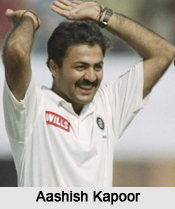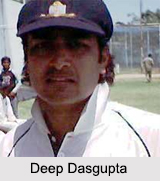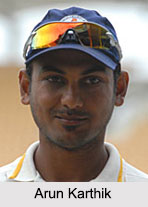 Shute Banerjee, also known as Sarobindu Nath Shute Banerjee, was an Indian cricket player who had played for India in one official and five unofficial Test matches. He was born on 3rd October 1911 in Kolkata, West Bengal. He played primarily as a right-arm medium pace bowler and a lower order batsman. His stock delivery was known to move in to the batsman on and off the wicket. After his first tour of England in the year 1936 he developed the inswing. Occasionally he also bowled as an outswinger and had a slower ball in the form of a leg break. He mostly played as a tail end batsman but sometimes he was also shifted up the order as an opener. Shute Banerjee died on 14 October 1980 in Kolkata.
Shute Banerjee, also known as Sarobindu Nath Shute Banerjee, was an Indian cricket player who had played for India in one official and five unofficial Test matches. He was born on 3rd October 1911 in Kolkata, West Bengal. He played primarily as a right-arm medium pace bowler and a lower order batsman. His stock delivery was known to move in to the batsman on and off the wicket. After his first tour of England in the year 1936 he developed the inswing. Occasionally he also bowled as an outswinger and had a slower ball in the form of a leg break. He mostly played as a tail end batsman but sometimes he was also shifted up the order as an opener. Shute Banerjee died on 14 October 1980 in Kolkata.
Shute Banerjee debuted in first class cricket at the age of 19 by representing Indians and Anglo-Indians in Bengal team in 1933-34 against the touring MCC. In 1935-36 he took 5 for 53 for a joint Bengal and Assam side against Jack Ryder"s Australian team. Following this he got selected for the third unofficial test against the same side. For this, he also missed the first edition of Ranji Trophy match for Bengal. He also earned a place in the Indian team to tour England in 1936. However due to the presence of the fast bowlers like Jahangir Khan, Amar Singh and Mohammad Nissar, he could not play in any of the Test matches.
In 1937-38, he played in the Ranji Trophy for Bengal and grabbed 5 for 33 against Central India. In the semi-final, he also scored a crucial 47 not out against Hyderabad. However he accepted a job in the state service of Jamnagar, just prior to the final against Nawanagar. Thus he became ineligible for the final. He was later invited to play for Cricket Club of India against the Lord Tennyson"s XI and in the inaugural match he took 6 for 89 in the Brabourne Stadium. He got three caps in the unofficial Tests against the same side and exhibited ordinary performances in the following matches.
In November 1941 Shute Banerjee rendered his career best bowling performance for Nawanagar against Maharashtra by taking 8 for 25 in little over an hour. He also top scored in both the innings. In the next year he joined Tatas in Jamshedpur and spent the rest of his life in Bihar. In 1945-46 he made a single appearance in the unofficial test against the Australian Services XI and bagged eight wickets. Surprisingly he also got selected in the Indian team to England in 1946. In 1946, Shute Banerjee made 315 runs and took 31 wickets in the tour matches. He took four wickets against Lancashire and Middlesex which helped India significantly to win the matches. Against Surrey at the Oval Shute Banerjee joined Chandu Sarwate at the last position when the score was 205 for 9. Banerjee made 121 while Sarwate scored 124 not out and it was the only instance of the No.10 and No.11 scoring hundreds in the same innings.
In 1948-49, back in India, Banerjee grabbed 7 for 67 for East Zone against West Indians in an innings. Later he also scored the final runs in a ten wicket victory which marked the only defeat of West Indies in the tour. For this, he got selected for the last Test of the series at the Brabourne Stadium at the age of 37. In the second innings he took 4 wickets quickly and also hit a six over midwicket. In the next three years, India did not play any Test cricket and thus the Brabourne Test became the only Test played by Banerjee in his career. In 1949 at Jamshedpur Banerjee played in domestic cricket for Bihar against Delhi and took a hat-trick by bowling out the Delhi players in thirty nine minutes. Subsequently against Odisha he scored 43 and 110 which were the top scores in both innings, also taking 6 for 37. He continued to be a part of Ranji Trophy for another decade; however his performance declined over time. He captained the team of Bihar since his joining but in the later years he gave up the captaincy. In one of the Ranji Trophy matches, Banerjee scored his highest first class score of 138. In late fifties, he moved to Bhilai and played for Madhya Pradesh in his final season in 1959-60.




























